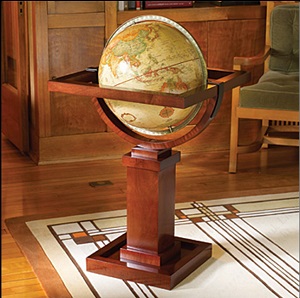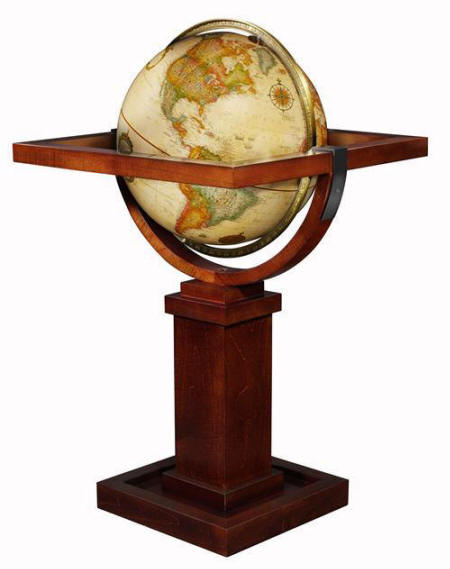|
||||
|
||||
|
World Globes> Replogle Floor Globes > Wright Floor World Globe
Wright - Floor Standing World Globe by Replogle Globes
-
Sale
Price: $1,250 (free
shipping/handling)
or 6 interest free installments of
$199.16 with
PayPal Credit
Retail
$
1,595
Unique world globe with floor stand features a fully up to date political boundaries map. The floor stand is inspired by a drawing by Frank Lloyd Wright (1867 - 1959) widely considered to be America's greatest architect.
|
|
Call us toll-free 877-822-9889 or 812-333-2772 for orders/questions Mon.-Sat. 10:00 am-5:30 pm Eastern Standard Time
 Full-swing antique style brass-plated die-cast meridian (ring supporting the globe) allows the ball to be turned 360° for convenient view of all points of interest from any possible angle. The globe revolves within the meridian (East/West), and the meridian swings within the stand (North/South). Time dial is located over the north pole, allowing viewers to calculate different time zones on the globe. Wood Finishes - additional colors available upon request. * Globe is inspired by Frank Lloyd Wright's architectural designs ** A portion of the sales supports the conservation and education programs of the Frank Lloyd Wright foundation.
The
Updatable Globe Program
A Quick Guide
to Understanding Your Globe
FINDING PLACES ON YOUR GLOBE: Although a globe is
round, with no beginning or end, there are two main reference lines from which
all distances and locations are calculated. One is the equator, running east and
west around the middle of the globe, dividing it into two equal halves. The
other is the prime meridian, an imaginary line running from pole to pole and
cutting through Greenwich, a section of London, England. Both of these lines are
0º and the globe numbering system starts at the point where they intersect. All
lines running east and west, parallel to the equator, are called latitude lines.
They are sometimes referred to as parallels because they are parallel to each
other. Latitude lines are shown at 15º intervals north and south of the equator.
Look at New Orleans on your globe and you will find it located at 30º. Since it
is north of the equator, we say it is 30º north latitude, or 30N. The lines
running north and south from pole to pole are called longitude lines, sometimes
referred to as meridians. Longitude lines are numbered along the equator on your
globe at 15º intervals east and west of the prime meridian at Greenwich. Again
using New Orleans as an example, we find it located at 90º or 90º west of 0º
longitude. Thus, New Orleans is located at 30N latitude and 90W longitude. Prime
Meridian Latitude lines determine angular distances north or south of the
equator. Longitude lines determine angular distances east or west of the prime
meridian. Remember, latitude lines go from 0º at the equator to 90º at the
poles. Longitude lines go from 0º at the prime meridian to 180º, a point on the
exact opposite side of the globe. In giving a position, latitude is always
stated first. Lines of latitude and longitude appear on your globe only at
certain intervals; otherwise, they would cover up all other map detail.
USING THE TIME DIAL: You can tell the time of any place on Earth by counting the number of meridians and figuring one hour later for each one east of you or one hour earlier for each one west of you. Your globe has a time dial loosely capped over the north pole, and you will see that it is divided into twenty-four equal parts, each representing one hour (or one meridian). Numbering is from noon to midnight and from midnight to noon. Half the dial is dark to indicate the darkness hours from sunset to sunrise and half is light for daylight hours. Let us suppose you are in St. Louis. It is 10:00 A.M. and you want to know the time in Paris, in Cairo, and in Tokyo. Set the time dial so that 10:00 A.M. is directly in line with St. Louis, sighting along the 90ºW meridian. Now rotate the globe (the time dial turns with it) until you find Paris. Sighting up along the nearest meridian, you find it is 4:00 P.M. Turn the globe to Cairo and repeat the procedure. It is 6:00 P.M. there. Now, rotating the globe all the way to Tokyo, you find the day is over and it’s 1:00 A.M. the next morning. |
Wright Floor Standing World Globe by Replogle Globes, Item # 22712
Sale Price: $1250.00, Inspired by Frank Lloyd Wright Design, Current Cartography, Raised Relief, Wood Floor Stand
World Globes make great gifts for Geography Buffs, Mother's Day, Father's Day & Graduation. Perfect as Wedding, Anniversary, Retirement Gifts, Corporate Awards, Business & Executive Gifts, Bon Voyage & Birthday Presents
 It is an
unidentified concept for one of the Prairie Homes that Mr. Wright designed in the early 1900s. Cradling a 16" diameter globe, the maple stand's proportions
were calculated to match the scale of other
drawings from this time period.
It is an
unidentified concept for one of the Prairie Homes that Mr. Wright designed in the early 1900s. Cradling a 16" diameter globe, the maple stand's proportions
were calculated to match the scale of other
drawings from this time period.



